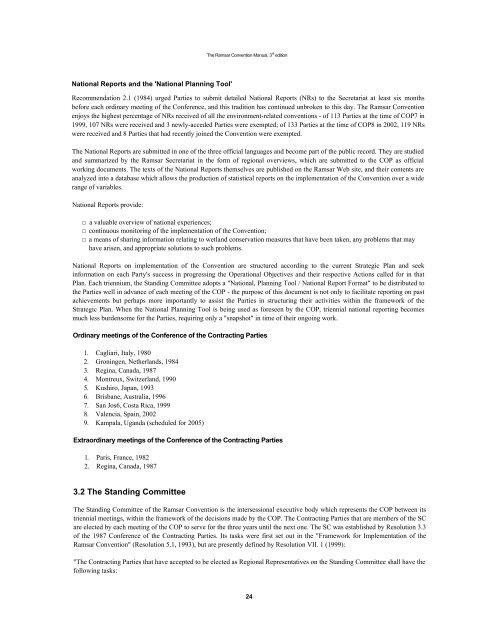The Ramsar Convention Manual.pdf
The Ramsar Convention Manual.pdf
The Ramsar Convention Manual.pdf
Create successful ePaper yourself
Turn your PDF publications into a flip-book with our unique Google optimized e-Paper software.
<strong>The</strong> <strong>Ramsar</strong> <strong>Convention</strong> <strong>Manual</strong>, 3 rd edition<br />
National Reports and the 'National Planning Tool'<br />
Recommendation 2.1 (1984) urged Parties to submit detailed National Reports (NRs) to the Secretariat at least six months<br />
before each ordinary meeting of the Conference, and this tradition has continued unbroken to this day. <strong>The</strong> <strong>Ramsar</strong> <strong>Convention</strong><br />
enjoys the highest percentage of NRs received of all the environment-related conventions - of 113 Parties at the time of COP7 in<br />
1999, 107 NRs were received and 3 newly-acceded Parties were exempted; of 133 Parties at the time of COP8 in 2002, 119 NRs<br />
were received and 8 Parties that had recently joined the <strong>Convention</strong> were exempted.<br />
<strong>The</strong> National Reports are submitted in one of the three official languages and become part of the public record. <strong>The</strong>y are studied<br />
and summarized by the <strong>Ramsar</strong> Secretariat in the form of regional overviews, which are submitted to the COP as official<br />
working documents. <strong>The</strong> texts of the National Reports themselves are published on the <strong>Ramsar</strong> Web site, and their contents are<br />
analyzed into a database which allows the production of statistical reports on the implementation of the <strong>Convention</strong> over a wide<br />
range of variables.<br />
National Reports provide:<br />
□ a valuable overview of national experiences;<br />
□ continuous monitoring of the implementation of the <strong>Convention</strong>;<br />
□ a means of sharing information relating to wetland conservation measures that have been taken, any problems that may<br />
have arisen, and appropriate solutions to such problems.<br />
National Reports on implementation of the <strong>Convention</strong> are structured according to the current Strategic Plan and seek<br />
information on each Party's success in progressing the Operational Objectives and their respective Actions called for in that<br />
Plan. Each triennium, the Standing Committee adopts a "National, Planning Tool / National Report Format" to be distributed to<br />
the Parties well in advance of each meeting of the COP - the purpose of this document is not only to facilitate reporting on past<br />
achievements but perhaps more importantly to assist the Parties in structuring their activities within the framework of the<br />
Strategic Plan. When the National Planning Tool is being used as foreseen by the COP, triennial national reporting becomes<br />
much less burdensome for the Parties, requiring only a "snapshot" in time of their ongoing work.<br />
Ordinary meetings of the Conference of the Contracting Parties<br />
1. Cagliari, Italy, 1980<br />
2. Groningen, Netherlands, 1984<br />
3. Regina, Canada, 1987<br />
4. Montreux, Switzerland, 1990<br />
5. Kushiro, Japan, 1993<br />
6. Brisbane, Australia, 1996<br />
7. San Jos6, Costa Rica, 1999<br />
8. Valencia, Spain, 2002<br />
9. Kampala, Uganda (scheduled for 2005)<br />
Extraordinary meetings of the Conference of the Contracting Parties<br />
1. Paris, France, 1982<br />
2. Regina, Canada, 1987<br />
3.2 <strong>The</strong> Standing Committee<br />
<strong>The</strong> Standing Committee of the <strong>Ramsar</strong> <strong>Convention</strong> is the intersessional executive body which represents the COP between its<br />
triennial meetings, within the framework of the decisions made by the COP. <strong>The</strong> Contracting Parties that are members of the SC<br />
are elected by each meeting of the COP to serve for the three years until the next one. <strong>The</strong> SC was established by Resolution 3.3<br />
of the 1987 Conference of the Contracting Parties. Its tasks were first set out in the "Framework for Implementation of the<br />
<strong>Ramsar</strong> <strong>Convention</strong>" (Resolution 5.1, 1993), but are presently defined by Resolution VII. 1 (1999):<br />
"<strong>The</strong> Contracting Parties that have accepted to be elected as Regional Representatives on the Standing Committee shall have the<br />
following tasks:<br />
24












